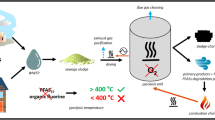Abstract
Direct disposal of flue gas scrubbing-derived waste water with a high level (9000–10,000 mg/L) of ammonium ion (NH4 +) into aquatic systems has contributed to environmental depreciation. Here, we report a feasibility study on NH4 + recovery and conversion to struvite (NH4MgPO4·6H2O), which is a slow-release fertilizer. Such conversion also aids in compliance with the discharge limits for nitrogen-based compounds. Lab-scale experiments were performed to determine the optimum pH and molar ratio (Mg2+:NH4 +:PO4 3−) for struvite formation. A chemical equilibrium model (Visual Minteq) was also employed to corroborate the experimental results. The optimum pH for struvite precipitation was found to be pH 9 with a molar ratio of Mg2+:NH4 +:PO4³− = 1:1:1. At this pH, more than 93, 92.3 and 100% of the NH4 +, Mg2+ and PO4 3−, respectively, were removed from the scrubbing waste water Visual Minteq simulation also demonstrated optimum struvite formation at pH 9–10. Both X-ray diffraction (XRD) and scanning electron microscopy/energy dispersive spectroscopy (SEM/EDS) analysis revealed that the synthesized struvite was comparable to that of a commercial struvite. Thus, our findings confirmed the possibility of synthesizing struvite from de-NOx scrubbing wastewater utilizing the residual ammonium ions (NH4 +).







Similar content being viewed by others
References
Lee SI, Weon SY, Lee CW, Koopman B (2002) Removal of nitrogen and phosphate from wastewater by the addition of bittern. Chemosphere 51:265–271
Celen I, Turker M (2001) Recovery of ammonia as struvite from digester effluents. Environ Technol 22(11):1263–1272
Zhang T, Ding L, Ren H (2009) Pretreatment of ammonium removal from landfill leachate by chemical precipitation. J Hazard mater 166:911–915
Ali MI (2005) Struvite crystallization from nutrient rich waste water, PhD Thesis, School of Engineering. James Cook University, Townsville
Stratful I, Scrimshaw MD, Lester JN (2001) Conditions influencing the precipitation of magnesium ammonium phosphate. Water Res 35(17):4191–4199
Yetilmezsoy K, Zengin ZS (2009) Recovery of ammonium nitrogen from the effluent of UASB treating poultry manure waste water by MAP precipitation as a slow release fertilizer. J Hazard Mater 166:260–269
Doyle JD, Parsons SA (2002) Struvite formation, control and recovery. Water Res 36:3925–3940
Zhang T, Ding L, Ren H, Xiong X (2009) Ammonium nitrogen removal from coking wastewater by chemical precipitation recycle technology. Water Res 43:5209–5215
Li XZ, Zhao QL, Hao XD (1999) Ammonium removal from landfill leachate by chemical precipitation. Waste Manag 19:409–415
Di Iaconi C, Pagano M, Ramadori R, Lopez A (2010) Nitrogen recovery from a stabilized municipal landfill leachate. Biores Technol 101:1732–1736
Diwani GE, Rafie SE, Ibiari NE, El-Aila HI (2007) Recovery of ammonia nitrogen from industrial wastewater treatment as struvite slow releasing fertilizer. Desalination 214:200–214
Li XZ, Zhao QL (2003) Recovery of ammonium-nitrogen from landfill leachate as a multi-nutrient fertilizer. Ecol Eng 20:171–181
Shu L, Schneider P, Jegatheesan V, Johnson J (2006) An economic evaluation of phosphorus recovery as struvite from digester supernatant. Biores Technol 97:2211–2216.
Celen I, Buchanan JR, Burns RT, Robinson RB, Raman DR (2007) Using an equilibrium model to predict amendments required to precipitate phosphorus as struvite in liquid swine manure. Water Res 41:1689–1696
Ali MI, Schneider PA (2008) An approach of estimating struvite growth kinetics incorporating thermodynamics and solution chemistry, kinetics and process description. Chem Eng Sci 63:3514–3525
Gustafsson JP, (2013) Visual Minteq ver. 3.0/3.1. KTH Royal institute of Technology, Sweden. http://vminteq.lwr.kth.se/visual-minteq-ver-3-0/
Gadekar S, Pullammanappallil P (2010) Validation and applications of a chemical equilibrium model for struvite precipitation. Environ Model Assess 15:201–209
Nelson NO, Mikkelsen RL, Hesterberg DL (2003) Struvite precipitation in anaerobic swine lagoon liquid: effect of pH and Mg:P ratio and determination of rate constant. Biores Technol 89:229–236
Hao XD, Wang CC, Lan L, Van Loosdrecht MCM (2008) Struvite formation, analytical methods and effects of pH and Ca++. Water Sci Technol 58(8):1687–1692
Cerrillo M, Palatsi J, Comas J, Vicens J, Bonmati A (2015) Struvite precipitation as a technology to be integrated into a manure anaerobic digestion treatment plant-removal efficiency, crystal characterization and agricultural assessment. J Chem Technol Biotechnol 90:1135–1143
Wu Y, Zhou S (2012) Improving the prediction of ammonium nitrogen removal through struvite precipitation. Environ Sci Pollut Res 19:347–360
Rahman MM, Salleh MAM, Rashid U, Ahsan A, Hossain MM, Ra CS (2014) Production of slow release crystal fertilizer from wastewaters through struvite crystallization–a review. Arab J chem 7:139–155
Mamais D, Pitt PA, Cheng YW, Loiacono J, Jenkins D (1994) Determination of ferric chloride dose to control struvite precipitation in anaerobic sludge digesters. Wat. Environ Res 66:912–918
Lin AY (2012) Precipitation of phosphate minerals from the effluent of anaerobically digested manure. Masters Thesis, Department of Civil Engineering, University of South Florida, USA
Acknowledgements
This work was financially supported by the Korean Ministry of Environment (No. 201400110019), and the authors are grateful for the instrument support by Kyung Hee University (KHU-20152127).
Author information
Authors and Affiliations
Corresponding author
Rights and permissions
About this article
Cite this article
Thapa, S., Ha, T.Y., Lee, H. et al. Recovery of ammonium ion as struvite from flue gas scrubbing wastewater. J Mater Cycles Waste Manag 20, 293–301 (2018). https://doi.org/10.1007/s10163-016-0579-8
Received:
Accepted:
Published:
Issue Date:
DOI: https://doi.org/10.1007/s10163-016-0579-8




